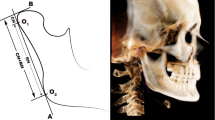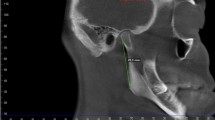Abstract
Objective
The purpose of this study was to compare the asymmetry index determined on digital panoramic radiographic (PR) images and posteroanterior cephalometric (PACR) images.
Methods
This study included 100 patients whose PR and PACR images were registered in a database. Condylar height, ramus height, and condylar height plus ramus height measurements were measured bilaterally. Condylar asymmetry, ramus asymmetry, and total asymmetry were evaluated.
Results
There was a statistically significant difference between the right and left side for all measurements when evaluated on the PR and also on the PACR images (p < 0.01). When calculating the asymmetry index, the resulting condylar asymmetry and ramus asymmetry values did not show significant differences between PR and PACR images. On the other hand, only the presence of total asymmetry showed a statistically significant difference between techniques (p = 0.013).
Conclusion
Asymmetry indices can be reliably obtained from both PR and PACR images.
Zusammenfassung
Zielsetzung
Ziel dieser Studie war es, den anhand von digitalen Panoramaröntgenbildern (PR) mit dem anhand von posteroanterioren Fernröntgenbildern (PACR) ermittelten Asymmetrieindex zu vergleichen.
Methoden
An dieser Studie nahmen 100 Patienten teil, deren PR- und PACR-Aufnahmen in einer Datenbank registriert waren. Kondylenhöhe, Ramushöhe und Kondylenhöhe plus Ramushöhe wurden beidseitig gemessen. Kondylenasymmetrie, Ramusasymmetrie und Gesamtasymmetrie wurden bewertet.
Ergebnisse
Bei allen Messungen gab es einen statistisch signifikanten Unterschied zwischen der rechten und der linken Seite, sowohl bei der Auswertung der PR- als auch der PACR-Aufnahmen (p < 0,01). Bei der Berechnung des Asymmetrieindexes zeigten die resultierenden Werte für die Kondylenasymmetrie und die Ramusasymmetrie keine signifikanten Unterschiede zwischen PR- und PACR-Aufnahmen. Andererseits zeigte nur das Vorhandensein einer Gesamtasymmetrie einen statistisch signifikanten Unterschied zwischen den Techniken (p = 0,013).
Schlussfolgerung
Asymmetrieindizes können sowohl aus PR- als auch aus PACR-Aufnahmen zuverlässig ermittelt werden.


Similar content being viewed by others
References
Anistoroaei D, Golovcencu L, Saveanu IC, Zegan G (2014) The prevalence of facial asymmetry in preorthodontic treatment. Int J Med Dent 18(3):210–215
Sezgin OS, Celenk P, Arici S (2007) Mandibular asymmetry in different occlusion patterns. Angle Orthod 77(5):803–807
Agrawal A, Bagga DK, Agrawal P, Bhutani RK (2015) An evaluation of panoramic radiograph to assess mandibular asymmetry as compared to posteroanterior cephalogram. APOS Trends Orthod 5(5):197–201
Ramirez-Yanez GO, Stewart A, Franken E, Campos K (2011) Prevalence of mandibular asymmetries in growing patients. Eur J Orthod 33(3):236–242
Rose JM, Sadowsky C, BeGole EA, Moles R (1994) Mandibular skeletal and dental asymmetry in class II subdivision malocclusions. Am J Orthod Dentofacial Orthop 105(5):489–495
Westesson PL, Tallents RH, Katzberg RW, Guay JA (1994) Radiographic assessment of asymmetry of the mandible. Ajnr Am J Neuroradiol 15(5):991–999
Vitral RW, Telles Cde S (2002) Computed tomography evaluation of temporomandibular joint alterations in class II division 1 subdivision patients: condylar symmetry. Am J Orthod Dentofacial Orthop 121(4):369–375
Huang M, Hu Y, Yu J, Sun J, Ming Y, Zheng L (2017) Cone-beam computed tomographic evaluation of the temporomandibular joint and dental characteristics of patients with class II subdivision malocclusion and asymmetry. Korean J Orthod 47(5):277–288
Habets LL, Bezuur JN, Naeiji M, Hansson TL (1988) The orthopantomogram, an aid in diagnosis of temporomandibular joint problems. II. The vertical symmetry. J Oral Rehabil 15(5):465–471
Almasan OC, Baciut M, Hedesiu M, Bran S, Almasan H, Baciut G (2013) Posteroanterior cephalometric changes in subjects with temporomandibular joint disorders. Dentomaxillofac Radiol 42(1):20120039
Alkis HT, Bilge OM (2019) Evaluation of mandibular asymmetry in angle malocclusion samples by posterioanterior cephalometric radiography: a preliminary study. Niger J Clin Pract 22(6):771–776
Kiki A, Kilic N, Oktay H (2007) Condylar asymmetry in bilateral posterior crossbite patients. Angle Orthod 77(1):77–81
Kurt G, Uysal T, Sisman Y, Ramoglu SI (2008) Mandibular asymmetry in class II subdivision malocclusion. Angle Orthod 78(1):32–37
Kjellberg H, Ekestubbe A, Kiliaridis S, Thilander B (1994) Condylar height on panoramic radiographs. A methodologic study with a clinical application. Acta Odontol Scand 52(1):43–50
Habets LL, Bezuur JN, van Ooij CP, Hansson TL (1987) The orthopantomogram, an aid in diagnosis of temporomandibular joint problems. I. The factor of vertical magnification. J Oral Rehabil 14(5):475–480
Iturriaga V, Navarro P, Cantin M, Fuentes R (2012) Prevalence of vertical condilar asymmetry of the temporomandibular joint in patients with signs and symptoms of temporomandibular disorder. Int J Morphol 30(1):315–321
Uysal T, Sisman Y, Kurt G, Ramoglu SI (2009) Condylar and ramal vertical asymmetry in unilateral and bilateral posterior crossbite patients and a normal occlusion sample. Am J Orthod Dentofacial Orthop 136(1):37–43
Kasimoglu Y, Tuna EB, Rahimi B, Marsan G, Gencay K (2015) Condylar asymmetry in different occlusion types. Cranio 33(1):10–14
Silvestrini-Biavati F, Ugolini A, Laffi N, Canevello C, Silvestrini-Biavati A (2014) Early diagnostic evaluation of mandibular symmetry using orthopantomogram. Indian J Dent Res 25(2):154–159
Kilic N, Kiki A, Oktay H (2008) Condylar asymmetry in unilateral posterior crossbite patients. Am J Orthod Dentofacial Orthop 133(3):382–387
Al Taki A, Ahmed MH, Ghani HA, Al Kaddah F (2015) Impact of different malocclusion types on the vertical mandibular asymmetry in young adult sample. Eur J Dent 9(3):373–377
Trpkova B, Prasad NG, Lam EW, Raboud D, Glover KE, Major PW (2003) Assessment of facial asymmetries from posteroanterior cephalograms: validity of reference lines. Am J Orthod Dentofacial Orthop 123(5):512–520
Eliasson S, Welander U, Ahlqvist J (1982) The cephalographic projection. Part I: general considerations. Dentomaxillofac Radiol 11(2):117–122
Grummons DC, Kappeyne van de Coppello MA (1987) A frontal asymmetry analysis. J Clin Orthod 21(7):448–465
Major PW, Johnson DE, Hesse KL, Glover KE (1994) Landmark identification error in posterior anterior cephalometrics. Angle Orthod 64(6):447–454
Leonardi R, Annunziata A, Caltabiano M (2008) Landmark identification error in posteroanterior cephalometric radiography. A systematic review. Angle Orthod 78(4):761–765
Houston WJ (1983) The analysis of errors in orthodontic measurements. Am J Orthod 83(5):382–390
Acknowledgements
Statistical analysis of this study was carried out by the Akdeniz University Statistical Consulting, Application and Research Center.
Funding
This study was not supported by any source of funding.
Author information
Authors and Affiliations
Corresponding author
Ethics declarations
Conflict of interest
H.T. Alkis and K.A. Pekince declare that they have no competing interests.
Ethical standards
This study was approved by the Clinical Research Ethics Committee of the Faculty of Medicine Akdeniz University, and the study was carried out in accordance with the ethical rules of the Declaration of Helsinki (ethics approval number 70904504/90). Consent to participate: Due to retrospective study design and the anonymization of the patients’ data, written informed consent was not necessary.
Additional information
Publisher’s Note
Springer Nature remains neutral with regard to jurisdictional claims in published maps and institutional affiliations.
Rights and permissions
About this article
Cite this article
Alkis, H.T., Pekince, K.A. Comparison of the asymmetry index determined on digital panoramic radiographic images and on posteroanterior cephalometric images: a retrospective cross-sectional study. J Orofac Orthop 84 (Suppl 3), 244–250 (2023). https://doi.org/10.1007/s00056-022-00442-2
Received:
Accepted:
Published:
Issue Date:
DOI: https://doi.org/10.1007/s00056-022-00442-2




